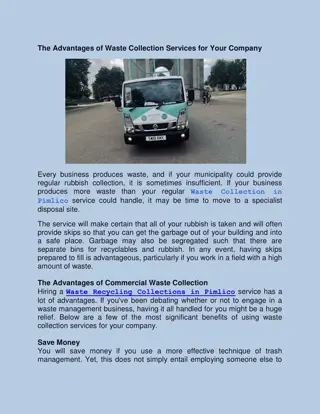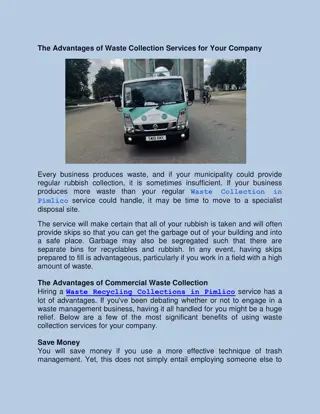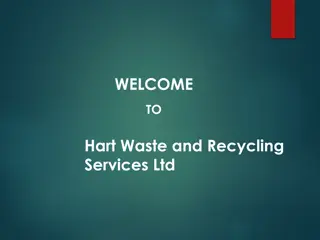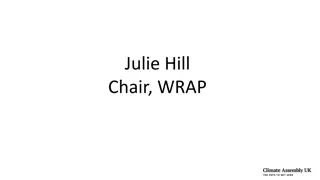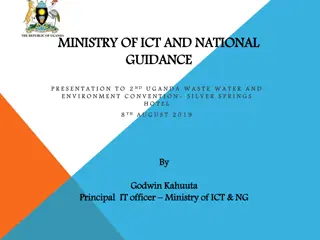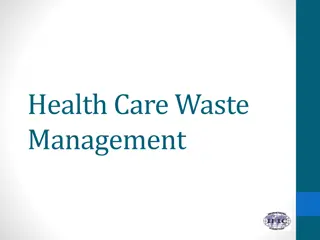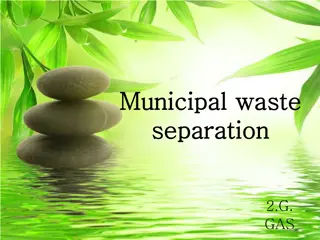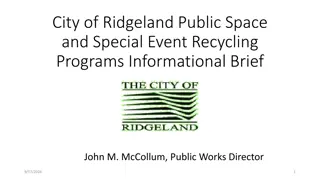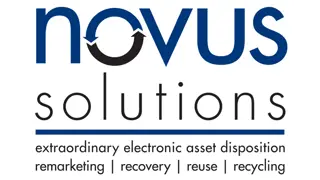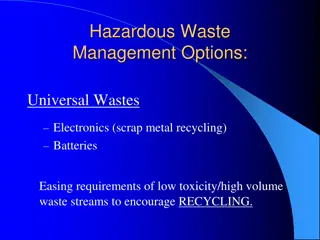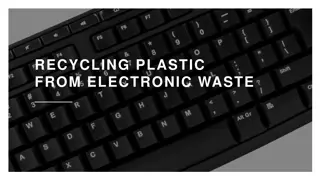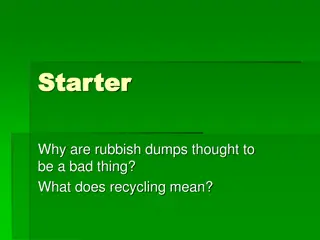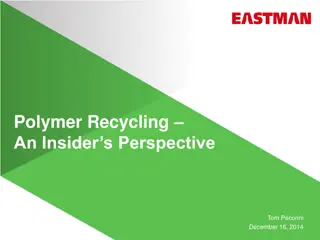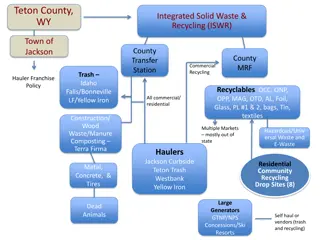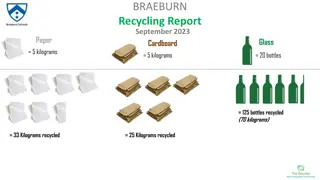Understanding E-Waste Recycling: Benefits and Challenges
Electronic waste (E-waste) poses significant environmental and health risks due to its toxic components. Proper handling and recycling of E-waste can bring economic and environmental benefits. While some states in the United States have effective E-waste collection and recycling programs, there is a lack of federal legislation. Investing in technology, public education, and incentives for manufacturers can promote responsible E-waste management and contribute to a sustainable future.
Uploaded on Sep 21, 2024 | 0 Views
Download Presentation

Please find below an Image/Link to download the presentation.
The content on the website is provided AS IS for your information and personal use only. It may not be sold, licensed, or shared on other websites without obtaining consent from the author. Download presentation by click this link. If you encounter any issues during the download, it is possible that the publisher has removed the file from their server.
E N D
Presentation Transcript
- E-Waste - The cost of recycling and it s economy benefits. Paul Jacobs Environmental Economics ECON 2505ID Prof. Sean P. MacDonald Date: 12/7/2016
WHAT IS E-WASTE? Electronic waste or E-waste includes all electronic and electrical appliances such as computers, mobile phones, digital music recorders/players, refrigerators, washing machines, and televisions. It can contain toxic substances that are hazardous to one s health and the environment. E-waste is rapidly having a global impact.
UNDERSTANDING E-WASTE The expense of collecting E-waste The economic and environmental benefits of properly handling E-waste in the United States
E-WASTE RECYCLING AND RECOVERY IN THE UNITED STATES Presently, there is no federal legislation to recycle e-waste in the United States, (Goodwill Industries International, 2010; Namias, 2013; Hawkins, 2016). One US smelter in Massena, New York receives a $70 million aid package from the state to continue its operation; only six smelters exist in the United States now (Hawkins, 2016). Minnesota, Oregon, and Washington are the states with the highest per capital collection volumes of e-waste (Namias, 2013).
E-WASTE RECYCLING AND RECOVERY IN THE UNITED STATES (CONT D) The findings about the e-waste collection and recycling programs in these states included (a) the high collection volumes correlate with collection convenient or with established collection goals; (b) the states with high collection volumes have laws that cover collection costs, encourage a variety of collector types to include government, private and non-profit; and (c) the landfill bans boost recycling levels (Namias, 2013).
ECONOMIC AND ENVIRONMENTAL BENEFITS OF E-WASTE Developing new technological solutions and educating the public on recycling, reusing, and disposing of various electronics will encourage more social responsibility for E-waste as it relates to the environment as a global concern (Bhutta et al (2011). Goodwill (2010) supports manufacturers who take back more than their market share of covered electronic devices through incentives, and pay a minimum price for covered electronic devices per pound beyond their annual goals.
ECONOMIC AND ENVIRONMENTAL BENEFITS OF E-WASTE (CONT D) Goodwill (2010) promotes the use of a green job to include recycling, computer refurbishing, and green building construction at the local, state and federal government levels. To encourage the refurbishing of computers to help the environment, Goodwill has also created training programs. For the drop of covered electronic devices, some Goodwill agencies charge a nominal fee to consumers since recyclers often charge Goodwill to collect covered electronics.
THE LOWER EAST SIDE ECOLOGY CENTER This selected field research site has a central location that is a community based resource Offers services and education for a wide range of environmental topics including the organics collection (composting), the electronic waste recycling, and the stewardship of public green spaces. Provides opportunities for all New Yorkers to learn more about the environmental issues that New York City has to deal with, and provides resources and solutions that address these issues.
THE LOWER EAST SIDE ECOLOGY CENTER (CONTD) Since 2003, the Ecology Center has successfully redirected millions of pounds of e-waste from landfills that would otherwise pollute the environment with heavy metals and chemical toxins. The United States Environmental Protection Agency (EPA) (2015) reports that e-waste accounts for 70% of the toxins found in landfills making up only 1% of its volume.
SUMMARY Enforcement of legislation for the proper disposal of E-waste in the United States Eliminate the need to ship e-waste overseas as a source for job growth within the U.S. Educate the public on recycling, reusing, and disposing of various electronics to encourage more social responsibility regarding E- waste.
REFERENCES Bhutta, M.K.S., Omar, A., & Yang, X. (2011). Electronic waste: A growing concern in today s environment. Economics Research International, 2011, 1-8. Goodwill Industries International. (2010). E-waste and the environment. The case for electronics recycling legislation. Retrieved from http://www.goodwill.org/wp-content/uploads/2011/01/Ewaste-Paper.pdf
REFERENCES (CONTD) Hawkins, A. (2016). E-waste empire. Retrieved from http://www.theverge.com/2016/6/22/11991440/eri-e-waste-electronics- recycling-nyc-gadget-trash Namias, J. (2013). The future of electronic waste recycling in the United States. Obstacles and domestic solutions. Columbia University. New York, New York. United States.
REFERENCES (CONTD) United States Environmental Protection Agency (2015). Cleaning Up Electronic Waste (E-Waste). https://www.epa.gov/international-cooperation/cleaning- electronic-waste-e-waste.


